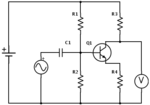krazyfencer
Junior Member level 2

- Joined
- Aug 5, 2013
- Messages
- 23
- Helped
- 0
- Reputation
- 0
- Reaction score
- 0
- Trophy points
- 1
- Location
- East Coast, USA
- Activity points
- 266
Hello,
I am trying to make a superhet broadcast receiver. I had a few questions about the preamplifier. Here is roughly what I am thinking:

1) What amount of gain should I be aiming for in the preamp?
2) Is it worth chaining multiple transistors in the preamp to get a large gain, or does this make the noise figure insanely large?
3) When choosing a transistor for Q1, would something like a 2N3094 work for broadcast am (say 560kHZ to 1600kHZ)?
4) For a transistor, am I basically looking for anything where the data sheet puts the max frequency as an amplifier above the input frequency I care about, and some noise figure that doesn't seem giant? Are there other factors to worry about?
Thanks for bearing with me, radio is cool (once I figure out how to do it)!
I am trying to make a superhet broadcast receiver. I had a few questions about the preamplifier. Here is roughly what I am thinking:

1) What amount of gain should I be aiming for in the preamp?
2) Is it worth chaining multiple transistors in the preamp to get a large gain, or does this make the noise figure insanely large?
3) When choosing a transistor for Q1, would something like a 2N3094 work for broadcast am (say 560kHZ to 1600kHZ)?
4) For a transistor, am I basically looking for anything where the data sheet puts the max frequency as an amplifier above the input frequency I care about, and some noise figure that doesn't seem giant? Are there other factors to worry about?
Thanks for bearing with me, radio is cool (once I figure out how to do it)!


